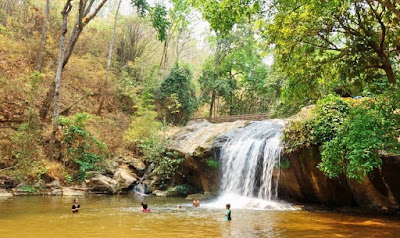Well-known tea production areas in Vietnam are Mộc Châu, Thái Nguyên, Lâm Đồng and Phú Thọ, but when it comes to tea trees of hundreds of years old, the important provinces are on the axis from the northeast to the northwest such as Hà Giang, Lào Cai, Yên Bái, Sơn La and Điện Biên.
My search for old tea trees was motivated by tales about a tree hundreds of years old in the Hà Giang highlands that grows wild and has a white down. Monkeys are trained to pick this tea, because the job is dangerous for humans.
The trees are called chè (tea) san tuyết (san – transcription of a Chinese word which means mountain and tuyết means snow).
I started along the mountain range of West Con Linh in Hà Giang Province. This province shares its border with China on its northeast side. I was disappointed to find that some very big plantation tea trees – two or three people can barely join hands around the trunk – had been cut down, milled and sold away to China since 2008. The law does not prohibit the felling of plantation tea trees. There are only trees with trunks 20 cm to 40 cm across left. According to the tea-growers I have met, tea trees 20 cm across are 60 to 80 years old.
.
Until recent decades, the Dao ethnic groups used to grow tea trees. Above their doors they used to hang bundles of tea for the treatment of stomach upset or ailments caused by the weather or miasmas.
The lowlanders have known about the old san tuyết tea trees in Hà Giang since 1979 when their soldiers went to the frontier to defend the country against an invading Chinese.
.
.
Mr Ngo Viet Thanh, a tea dealer in Hà Giang, told me that san tuyết tea trees in Hà Giang grew untended on the highlands above 1,000 metres. The san tuyết tea in Hà Giang has a tart taste when drunk for the first time due to a high level of tannin, but then the taste becomes pleasantly sweet. ‘The ethnic people consider this a gift from the heavens and pick they take it without having to tend it’, he said.
Mr Thanh in 1993 he began to be interested san tuyết tea. He went to hamlets and villages in the Hà Giang highlands to bring it to the lowland markets. I accompanied him to the Nhìu Sang Dao hamlet, in the commune of Xín Chải, Vị Xuyên District, Hà Giang Province. It took us more than two hours to go 50 kilometres in a Russian automobile, covering steep, stony and dangerous tracks along the Vietnam-China border, with precipitous slopes above and below.
The old tea trees in Nhìu Sang, close to the Dao houses, have a diameter of 20 cm and more. A dozen kilometres away from Nhìu Sang, where the Mông Hoa (Flower Hmong) ethnic group live in Lao Chải, there are tea trees with trunks that can only just be circled by the arms join clasping hands. Mr Thanh said ‘It was hard to transport the tea out because of the tracks full of obstacles. People picked the tea, dried it in the sun, and sold it to Chinese merchants. It is a few kilometres from Lao Chải to China.
I was told that on top of Mount Fansipan, in the Hoàng Liên Sơn mountain range, there were tea trees hundreds of years old.
Having got through a number of paperwork formalities that required waiting two days, I had permission to enter Hoàng Liên National Park on foot in search of old tea trees. The path I travelled on there was the one travellers take for the peak of Mount Fansipan, the highest mountain in Vietnam.
At an altitude of 2,200 metres, I and my guide came to a fork. On the right a path led to Fansipan’s top. We took to the left, leading to a ravine. The guide warned me that the area where the tea trees grew had a warm climate that favoured several kinds of snakes.
The first tea tree I found was about a metre in diameter and taller than I could estimate. It was hard to recognize it as a tea tree because the whole area was dark green, every root covered with a lush, green moss. Under the canopy was a fern forest. Although I had seen several old tea trees, I had never seen such lofty and big ones. The trunks were close to each other and covered with a white mould. This made the tea trees very different from the other kinds of trees in the area. The guide told me that from the altitude of 2,200 metres up to 2,800 metres, there were old tea trees everywhere and the higher we got the smaller and shorter they would be.
.
.
Ha Giang tea tree remains productive after 500 years
A 500-year-old Shan tuyet tea tree in the northern mountainous province of Ha Giang still retains its productivity and the special taste of its leaves.
A 500-year-old Shan tuyet tea tree in the northern mountainous province of Ha Giang still retains its productivity and the special taste of its leaves.
TEA TOURISTS
















